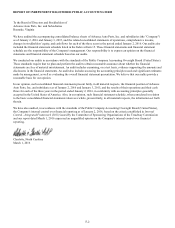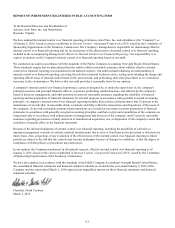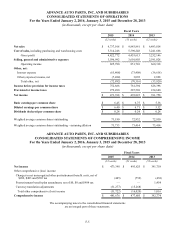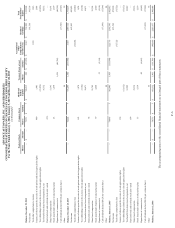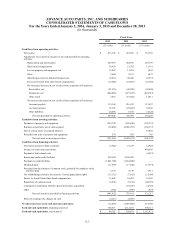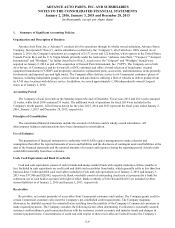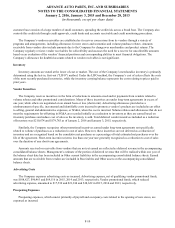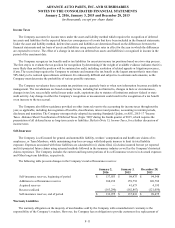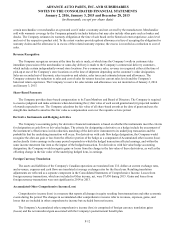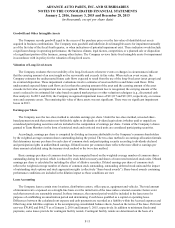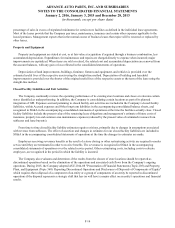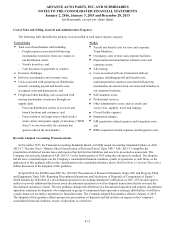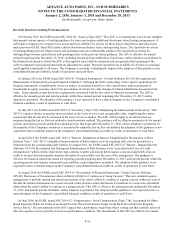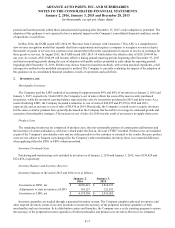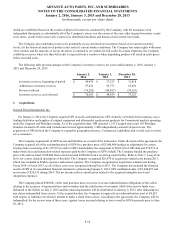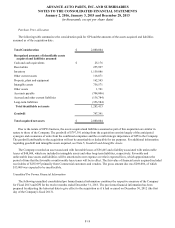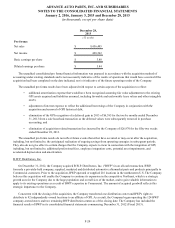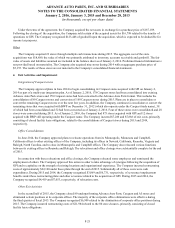Advance Auto Parts 2015 Annual Report Download - page 66
Download and view the complete annual report
Please find page 66 of the 2015 Advance Auto Parts annual report below. You can navigate through the pages in the report by either clicking on the pages listed below, or by using the keyword search tool below to find specific information within the annual report.ADVANCE AUTO PARTS, INC. AND SUBSIDIARIES
NOTES TO THE CONSOLIDATED FINANCIAL STATEMENTS
January 2, 2016, January 3, 2015 and December 28, 2013
(in thousands, except per share data)
F-12
certain merchandise or merchandise at a prorated cost if under a warranty and not covered by the manufacturer. Merchandise
sold with warranty coverage by the Company primarily includes batteries but may also include other parts such as brakes and
shocks. The Company estimates its warranty obligation at the time of sale based on the historical return experience, sales level
and cost of the respective product sold. To the extent vendors provide upfront allowances in lieu of accepting the obligation for
warranty claims and the allowance is in excess of the related warranty expense, the excess is recorded as a reduction to cost of
sales.
Revenue Recognition
The Company recognizes revenue at the time the sale is made, at which time the Company’s walk-in customers take
immediate possession of the merchandise or same-day delivery is made to the Company’s commercial delivery customers,
which include certain independently-owned store locations. For e-commerce sales, revenue is recognized either at the time of
pick-up at one of the Company’s store locations or at the time of shipment depending on the customer’s order designation.
Sales are recorded net of discounts, sales incentives and rebates, sales taxes and estimated returns and allowances. The
Company estimates the reduction to sales and cost of sales for returns based on current sales levels and the Company’s
historical return experience. The Company’s reserve for sales returns and allowances was not material as of January 2, 2016
and January 3, 2015.
Share-Based Payments
The Company provides share-based compensation to its Team Members and Board of Directors. The Company is required
to exercise judgment and make estimates when determining the (i) fair value of each award granted and (ii) projected number
of awards expected to vest. The Company calculates the fair value of all share-based awards at the date of grant and uses the
straight-line method to amortize this fair value as compensation cost over the requisite service period.
Derivative Instruments and Hedging Activities
The Company’s accounting policy for derivative financial instruments is based on whether the instruments meet the criteria
for designation as cash flow or fair value hedges. The criteria for designating a derivative as a hedge include the assessment of
the instrument’s effectiveness in risk reduction, matching of the derivative instrument to its underlying transaction and the
probability that the underlying transaction will occur. For derivatives with cash flow hedge designation, the Company would
recognize the after-tax gain or loss from the effective portion of the hedge as a component of Accumulated other income (loss)
and reclassify it into earnings in the same period or periods in which the hedged transaction affected earnings, and within the
same income statement line item as the impact of the hedged transaction. For derivatives with fair value hedge accounting
designation, the Company would recognize gains or losses from the change in the fair value of these derivatives, as well as the
offsetting change in the fair value of the underlying hedged item, in earnings.
Foreign Currency Translation
The assets and liabilities of the Company's Canadian operations are translated into U.S. dollars at current exchange rates,
and revenues, expenses and cash flows are translated at average exchange rates for the fiscal year. Resulting translation
adjustments are reflected as a separate component in the Consolidated Statements of Comprehensive Income. Losses from
foreign currency transactions, which are included in Other income, net, were $7,430 during 2015. Gains and losses from
foreign currency transactions were not significant in 2014 or 2013.
Accumulated Other Comprehensive Income (Loss)
Comprehensive income (loss) is a measure that reports all changes in equity resulting from transactions and other economic
events during the period. The changes in accumulated other comprehensive income refer to revenues, expenses, gains, and
losses that are included in other comprehensive income but excluded from net income.
The Company’s Accumulated other comprehensive income (loss) is comprised of foreign currency translation gains
(losses) and the net unrealized gain associated with the Company's postretirement benefit plan.


